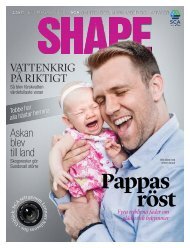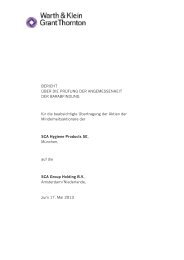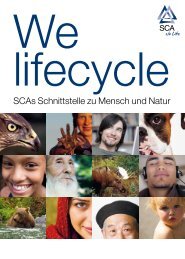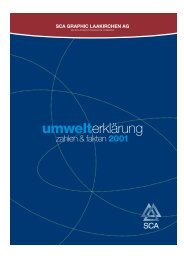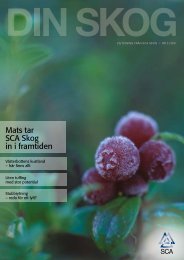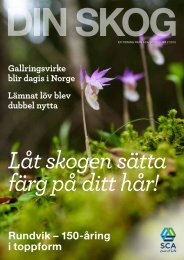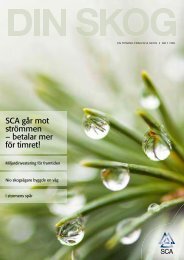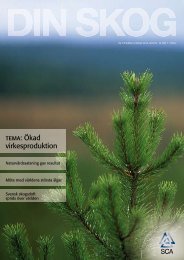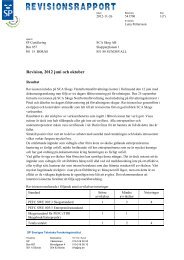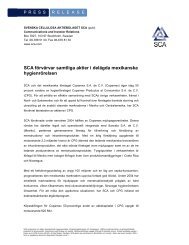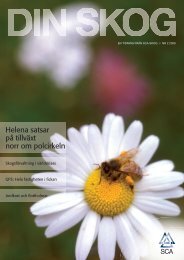SCA Graphic Paper Polska
SCA Graphic Paper Polska
SCA Graphic Paper Polska
You also want an ePaper? Increase the reach of your titles
YUMPU automatically turns print PDFs into web optimized ePapers that Google loves.
Środowisko naturalne<br />
Ekoodcisk<br />
publicationpapers.sca.com<br />
Najważniejszą przyczyną zmian klimatu jest emisja dwutlenku<br />
węgla pochodzącego z paliw kopalnianych. Inną ważną przyczyną<br />
jest rabunkowy wyręb lasów, z jakim mamy do czynienia w<br />
niektórych częściach świata. Mówiąc wprost – musimy zmniejszyć<br />
emisję dwutlenku węgla, a także związać więcej tego, który już<br />
został uwolniony do atmosfery.<br />
Kluczową rolę odgrywają tu lasy, ponieważ w<br />
dużej mierze składają się one z węgla zaabsorbowanego<br />
z atmosfery przez rosnące drzewa.<br />
Mierzenie ekoodcisku<br />
Ekoodcisk (ang. carbon footprint) to całkowita<br />
ilość gazów cieplarnianych emitowana<br />
przy wytworzeniu produktu lub usługi.<br />
Najważniejszym z nich jest dwutlenek węgla.<br />
Inne gazy cieplarniane, takie jak metan, przeliczane<br />
są na odpowiedniki dwutlenku węgla.<br />
Aby obliczyć ekoodcisk, należy dokonać<br />
analizy cyklu życia produktu, z uwzględnieniem<br />
wyłącznie jednego parametru – emisji<br />
dwutlenku wegla. W celu uzyskania pełnego<br />
ekoodcisku, należy uwzględnić także inne<br />
aspekty. CEPI opracowało strukturę obejmującą<br />
wszystkie niezbędne elementy.<br />
Oto dziesięć elementów ekoodcisku:<br />
1. Sekwestracja dwutlenku węgla w lasach<br />
2. Dwutlenek węgla w produktach leśnych<br />
3. Poziom emisji podczas produkcji<br />
4. Poziom emisji przy pozyskiwaniu włókna<br />
5. Poziom emisji podczas wytwarzania innych<br />
surowców<br />
6. Poziom emisji przy produkcji energii<br />
7. Poziom emisji podczas transportu<br />
8. Emisja spowodowana użytkowaniem<br />
produktów<br />
9. Emisja spowodowana utylizacją produktu<br />
10. Emisja, której uniknięto<br />
1.400<br />
1.200<br />
1.000<br />
800<br />
600<br />
1.189<br />
8%<br />
74%<br />
3%<br />
1%<br />
Carbon Profile <strong>SCA</strong> <strong>Graphic</strong> Laakirchen AG<br />
2009<br />
Declaration of the emission of fossile CO 2 associated with paper production<br />
and transports of raw materials and finished products. The calculation follows<br />
the CEPI* - guidlines for carbon footprint of paper & board products.<br />
14%<br />
53<br />
manufacturing<br />
fiber production<br />
other raw material<br />
purchased energy<br />
transport<br />
CO 2 emission in relation<br />
[kg CO 2 / t paper]<br />
400<br />
643<br />
200<br />
336<br />
0<br />
stored in product transport production avoided emissions<br />
CO2-emissions [kg CO2 / t paper]<br />
manufacturing 23<br />
fiber production 4<br />
other raw material 98<br />
purchased energy 519<br />
sum<br />
643<br />
transport<br />
53<br />
TOTAL<br />
696<br />
Carbon is also stored in the product<br />
in wood fibers and fillers; calculation<br />
follows the recommendation of the<br />
Intergovernmental Panel on Climate<br />
Change (IPCC) for wood products.<br />
This CO 2 is considered as biogenic.<br />
Avoided emissions report measures<br />
already taken to reduce CO 2 emissions.<br />
Besides the complete picture given by the CEPI* Framework for Carbon Footprints other rules report parts of the full<br />
calculation. These figures are given as excerpt from the CEPI* calculation :<br />
" <strong>Paper</strong><br />
Profile"<br />
Parts<br />
of<br />
El.<br />
3+<br />
6 ( em.<br />
from<br />
paper<br />
prod.<br />
, purchased<br />
pulp<br />
and<br />
steam)<br />
[kg CO2 / t paper]<br />
197<br />
" WWF<br />
<strong>Paper</strong><br />
Scorecard"<br />
Part<br />
of<br />
Element<br />
3 ( direct<br />
emissions)<br />
+ 6 ( purchased<br />
energy)<br />
523<br />
The given figures represent meanvalues for the reported year and cover verified 10. 5. 2010 by<br />
the range of brands produced at : <strong>SCA</strong> <strong>Graphic</strong> Laakirchen AG<br />
Contact person Nikolaus Kaindl<br />
GraphoNova, GraphoPrestige,<br />
GraphoGrande,<br />
Address<br />
<strong>SCA</strong> <strong>Graphic</strong> Laakirchen AG<br />
GraphoSet, GraphoVerde, GraphoGravure A-4663 Laakirchen, Schillerstraße 5<br />
Phone +43 7613 8800 0<br />
*CEPI - Confederation of European <strong>Paper</strong> Industries E-mail<br />
nikolaus.kaindl@sca.com<br />
Dane dotyczące naszych papierów znaleźć<br />
można w części „Certyfikaty” niniejszego opracowania<br />
lub na stronie:<br />
www.publicationpapers.sca.com.



